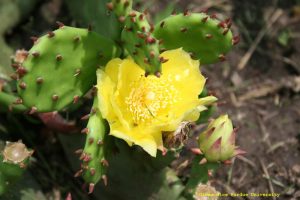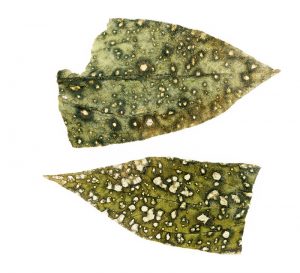
Pricklypear cactus
Photo credit: Glenn Nice, formerly Purdue University
Q. How do I keep cactus out of my yard? They grow somewhat flat on the ground and have yellow flowers. I have sandy soil – I call them sand cactus. I keep digging them up, but can’t seem to get rid of them. – D.C.
A. The eastern picklypear cactus, Opuntia humifusa, is native to most of the U.S. including Indiana and is considered beautiful and valuable by many. But it certainly can be a weedy pest that is quite difficult to control. Pricklypear is pollinated primarily by bees, and the resulting fruit are consumed by wildlife, which then spread the seeds. The stems are segmented into flattened sections that root readily to form new plants. These stem sections can float in times of flood and take root when they reach dry land.
There’s no easy remedy. Mowing only serves to propagate the plant and spread it throughout the yard. The plants are quite resistant to herbicide, though some success has been reported with the product called triclopyr. Read the label and use caution as this product is more likely to damage other desirable species growing near the cactus.
Repeated digging can be successful – use a pick or shovel to dig 2-4 inches below the soil surface. Be sure to wear thick gloves, long sleeves, pants and eye protection. Take care to remove all pieces of the cactus. Additional information can be found at https://ag.purdue.edu/stories/unexpected-plants-and-animals-of-indiana-eastern-prickly-pear-cactus/.

Zinnia leaf spots
Photo credit: D.W., Ridgeville, Indiana
Q. I grow a lot of zinnias in my garden. They have always done well there. This year, the leaves were covered with spots and shriveled and died. The flowers looked good, though. Is there something I can do to slow it down for next year? – D. W., Ridgeville, Indiana.
A. Zinnias suffer from a number of leaf diseases, including some caused by fungi and another by bacteria. Effective control will first require accurate diagnosis and hinges on protecting healthy foliage to prevent further infection. At this late stage of the growing season, I recommend good fall cleanup of the planting area, removing all plant residue to reduce overwintering pathogens. If the problem repeats next year, get a sample in to the Purdue Plant and Pest Diagnostic Lab as soon as symptoms appear. Seewww.ppdl.purdue.edu for additional information on submitting plant samples.
Q. The moles are tearing up my yard. I have tried all kinds of products to get rid of them, but so far nothing does the job. Is there anything you recommend? – J. H., Anderson, Indiana.
A. According to USDA Animal Damage Control, “trapping is the most reliable method of mole control. The key to success is patience, practice and persistence. Moles have an uncanny ability to detect and spring improperly set traps.” You’ll find more information on when and where to trap and additional control strategies athttp://www3.ag.purdue.edu/entm/wildlifehotline/pages/moles.aspx